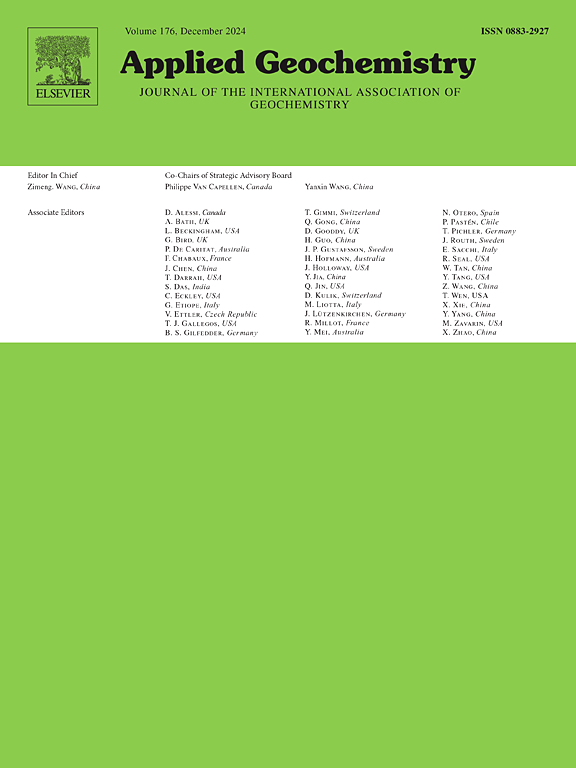Radionuclide release from spent nuclear fuel in sealed glass ampoules
IF 3.1
3区 地球科学
Q1 GEOCHEMISTRY & GEOPHYSICS
引用次数: 0
Abstract
Radiation from spent nuclear fuel affects the redox chemistry of water in the proximity of the fuel surface. The overall effect of the radiolysis is oxidizing so that U(IV) in the spent nuclear fuel is oxidized to U(VI). The dissolution of U(VI) is relatively fast, especially when the water contains bicarbonate. Based on this, radiolytic oxidation is considered the main driving force for spent fuel dissolution and radionuclide release in a spent fuel repository environment, and many studies over the years have aimed to further our understanding of this process and how it is influenced by available redox active components in open and closed systems. Here, data from sealed glass ampoules in which spent fuel is leached for one and five years, are compared with published data from a previous similar experiment. With regards to evolution of radiolytic gases, the results are comparable to the results from the previous experiments: a steady state with regards to oxygen and hydrogen composition is observed. An unexpected observation is that some ampoules with old, pre-oxidized fragments produced less radiolytic gases. These older fragments release a larger fraction of the radionuclide inventory of the samples, yielding concentrations that are on the same level as previously published data. The data from the old fragments presented here are affected by the pre-oxidation and prolonged washing procedure, which confounds the interpretation of those data. New, recently prepared fragments yield data that are easier to interpret. The radionuclide concentrations in the ampoules with new fragments are much lower; uranium concentrations of ca 5E-6 M after one year, and ca 3E-5 M after five years. Using the calculated radionuclide inventory in the fuel samples, an apparent radionuclide release rate in these initially anoxic systems, based on U release, is ca 3E-5 per year.
密封玻璃安瓿中乏核燃料释放的放射性核素
乏核燃料的辐射影响燃料表面附近水的氧化还原化学反应。放射性分解的总体效果是氧化,因此乏核燃料中的铀(IV)被氧化为铀(VI)。U(VI)的溶解比较快,特别是当水中含有碳酸氢盐时。基于此,放射性分解氧化被认为是乏燃料储存库环境中乏燃料溶解和放射性核素释放的主要驱动力,多年来的许多研究旨在进一步了解这一过程,以及开放和封闭系统中可用的氧化还原活性组分如何影响这一过程。在这里,从密封的玻璃安瓿中提取的数据,将乏燃料在其中浸出1年和5年,与之前发表的类似实验的数据进行比较。关于辐射分解气体的演化,结果与以前的实验结果相当:观察到氧和氢组成的稳定状态。一个意想不到的观察结果是,一些装有旧的、预氧化碎片的安瓿产生的放射性溶解气体较少。这些较老的碎片释放出的放射性核素在样本中所占比例较大,产生的浓度与以前公布的数据处于同一水平。这里展示的旧碎片的数据受到预氧化和长时间洗涤程序的影响,这混淆了这些数据的解释。新的,最近准备的片段产生的数据更容易解释。有新碎片的安瓿瓶中的放射性核素浓度要低得多;一年后铀浓度为5E-6 M,五年后为3E-5 M。利用计算出的燃料样品中的放射性核素库存,根据铀释放量,这些初始缺氧系统中的放射性核素表观释放率约为每年3E-5。
本文章由计算机程序翻译,如有差异,请以英文原文为准。
求助全文
约1分钟内获得全文
求助全文
来源期刊

Applied Geochemistry
地学-地球化学与地球物理
CiteScore
6.10
自引率
8.80%
发文量
272
审稿时长
65 days
期刊介绍:
Applied Geochemistry is an international journal devoted to publication of original research papers, rapid research communications and selected review papers in geochemistry and urban geochemistry which have some practical application to an aspect of human endeavour, such as the preservation of the environment, health, waste disposal and the search for resources. Papers on applications of inorganic, organic and isotope geochemistry and geochemical processes are therefore welcome provided they meet the main criterion. Spatial and temporal monitoring case studies are only of interest to our international readership if they present new ideas of broad application.
Topics covered include: (1) Environmental geochemistry (including natural and anthropogenic aspects, and protection and remediation strategies); (2) Hydrogeochemistry (surface and groundwater); (3) Medical (urban) geochemistry; (4) The search for energy resources (in particular unconventional oil and gas or emerging metal resources); (5) Energy exploitation (in particular geothermal energy and CCS); (6) Upgrading of energy and mineral resources where there is a direct geochemical application; and (7) Waste disposal, including nuclear waste disposal.
 求助内容:
求助内容: 应助结果提醒方式:
应助结果提醒方式:


